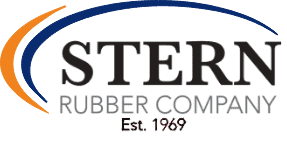What Is Compression Molding?
Compression molding is a rubber manufacturing process that starts with mixed raw material or a special rubber compound. The compound material is either cut or weighed, or a pre-form is created. The pre-forms take the basic shape of the final product. Since the material is compressed between parts of a cavity, more material is required than will be in the end product. This ensures the entire cavity of the rubber mold is filled with compound when the custom rubber product is created.
Benefits of Rubber Compression Molding
Rubber compression molding is a popular process across numerous industries due to its ability to produce high-quality components at a relatively low cost. Other key benefits of rubber compression molding include:
Cost-Efficiency
Because compression molding doesn’t involve a transfer or injection cycle, it offers lower tooling and equipment costs. This makes it a more cost-effective alternative to transfer and injection molding when it comes to producing custom parts. Additionally, creating a mold for compression molding is a one-time cost, meaning all subsequent runs will cost less than the initial run. Its cost-efficiency also makes rubber compression molding a good choice for prototyping as well as small production runs.
Versatility
Rubber compression molding offers a high degree of production flexibility and works well for components of various sizes, shapes, thicknesses, and production volumes. Since raw materials are loaded directly into the mold cavity, the process enables manufacturers to more easily create larger objects and thicker parts with special features. Compression molding can produce a wide range of durable, long-lasting parts that meet specific environmental and chemical requirements.
Repeatability
Compression molds can be used again and again to create identical parts. Once the mold is created, the process is easily repeatable and offers relatively fast cycle times, making it a great option for mass production.
Durability
Because compression-molded parts are made from rubber, they are naturally durable. Rubber components can withstand exposure to oil and moisture without degrading, making compression molding an ideal choice for producing O-rings and other seals.
Typical Rubber Compression Molding Applications
Rubber compression molding is a versatile manufacturing process that produces durable parts, making it useful for many applications. Common uses include:
- Fuel, Electrical, and HVAC Systems. Compression molding creates highly precise seals and other rubber parts designed to protect critical fuel, electrical, and HVAC systems.
- Seals and O-rings. The versatile process of compression molding is suitable for creating reliable gaskets, O-rings, seals, and large bulky components.
- Powersports. The powersports industry relies on rubber compression molding to produce parts such as O-rings and seals meant to protect closed systems.
- Food and Beverage Applications. Compression-molded seals and other components are commonly found on sterile rubber hoses for food and beverage applications.
- Kitchen Equipment. Many kitchen tools, appliances, and utensils have parts that are created using compression molding.
Rubber Compression Molding by Stern Rubber
Rubber compression molding offers numerous advantages that make it a popular choice for producing custom parts across diverse industries. At Stern Rubber Company, we’ve been providing custom-molded rubber products for our customers since 1969. With over five decades of experience, we have the necessary skills and expertise to deliver quality compression-molded products in low, medium, and high production volumes.
For more information about our rubber compression molding capabilities, or to get started on your custom solution, contact Stern Rubber Company today.
Get started today!
Or call 218.894.3898
